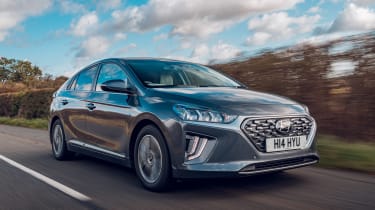Hyundai Ioniq Plug-In (2016-2022) review
The Hyundai Ioniq Plug-In is one of the most efficient hybrid cars around, and it’s practical too
Pros
- Quiet petrol engine
- Very good economy
- Room for five adults
Cons
- Dull to drive
- Interior materials feel cheap
- Just over 30-mile electric range
| Car type | Electric range | MPG | CO2 |
|---|---|---|---|
| Plug-in hybrid | 32 miles | 257mpg | 26g/km |
The Hyundai Ioniq was the brand’s original model to use the name – it’s not to be confused with the new Ioniq 5 and upcoming other models that will use it as well – but in July 2022 it went out of production. It was available in hybrid, electric and (as reviewed here) plug-in hybrid forms.
The Ioniq plug-in is a rival for models such as the Prius Plug-In, Kia Niro PHEV and Kia XCeed PHEV. It brought very low running costs because its aerodynamic hatchback shape and compact dimensions (next to the glut of plug-in SUVs available) allowed it to use a small engine and motor combination that brought impressive fuel economy and rock-bottom emissions.
The Ioniq was one of the first cars ever to be available in three electrified forms, as alongside the plug-in there were all-electric and full-hybrid models as well. Where this plug-in model really excelled was for company car drivers, as its 257mpg figure, 26g/km emissions and plug-in power meant that tax for business users was really low and fuel economy really high.
The Ioniq PHEV uses a frugal 1.6-litre 104bhp petrol engine with a 60bhp electric motor, plus an 8.9kWh battery. That’s quite a small battery for a plug-in, but the aerodynamic body means that it really makes the most of the available power and the electric driving range is still over 30 miles.
The 0-62mph time of 10.6 seconds is faster than a Toyota Prius Plug-in, and it has plenty of punch for overtaking and nipping through traffic.
You’ll have no complaints in town, with the Hyundai getting away quite smartly from the lights, although the Toyota Prius Plug-In is even more responsive. Drive gently and the electric motor will be the only thing powering the Ioniq. Put your foot down, though, and the petrol engine will cut in to assist. It’s a fairly refined thing that’s especially well suited to congested city streets and urban roads.
Switch the Ioniq to EV mode, which stops the petrol engine from cutting in, and you’ll be running on electric power for about 30 miles – useful if your journey starts or ends in a city. The Ioniq’s default mode is Hybrid, which smoothly alternates between electric and petrol power. As of the late 2019 update, the Plug-In now lets you control the strength of its regenerative braking effect using paddles on the back of the steering wheel.
The Ioniq was engineered with economy in mind, with low-resistance tyres, a hybrid powertrain and light steering – all of which means the driving experience is a bit numb. However, the dual-clutch automatic gearbox allows for snappy gear changes and comfort is generally good.
Hyundai created the Ioniq with a plug-in hybrid powertrain in mind from the outset. That allowed the designers to make the most of the car’s interior – there’s room for five adults inside and the boot capacity matches that of the Ioniq Electric, with 341 litres of luggage space.
You shouldn’t have to worry about reliability, but even if things do go wrong, Hyundai supplied a five-year/unlimited-mileage warranty on the vehicle and an eight-year warranty on the battery. And if you should be unfortunate enough to have an accident, the Ioniq offers some of the best protection for occupants – it received a five-star Euro NCAP crash-test rating, with impressive section scores.

You get plenty of equipment as standard on Hyundais, and the Ioniq Plug-In Hybrid is no exception, with an infotainment system featuring Apple CarPlay and Android Auto, plus LED headlights. There’s lots to keep tech-heads happy. then, but don’t examine the plastics too closely – some of them look and feel a bit low-rent.
Overall, despite being more expensive to buy than its Hybrid stablemate, the better fuel economy of the Plug-In gives it greater appeal. Not only that, but we reckon it's more well rounded overall than the Toyota Prius Plug-In Hybrid it competes with. For a more detailed look at the Hyundai Ioniq Plug-In Hybrid, read on for the rest of our in-depth review…





